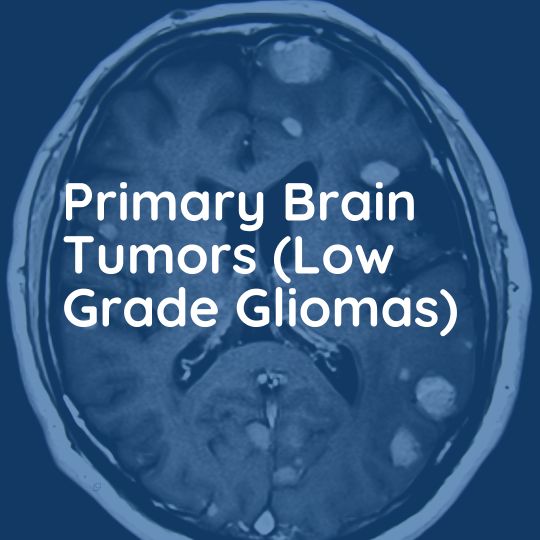
Primary Brain Tumors (Low Grade Gliomas)
Primary brain tumors are tumors that develop within the brain’s cells. Among these, low-grade gliomas stand out as a specific type. They originate from glial cells, which play a crucial role in supporting and nourishing neurons in the brain. Low-grade gliomas are termed “low-grade” due to their characteristic slow growth and less aggressive nature compared to high-grade gliomas, another primary brain tumor variety that tends to progress rapidly and be more aggressive. These low-grade gliomas can manifest in various brain regions and may or may not exhibit symptoms, contingent upon their size and location.
Causes
Symptoms
Treatment
Causes
- Genetic Mutations: Describes how mutations in certain genes can increase the risk of developing primary brain tumors.
- Exposure to Radiation: Explains how exposure to radiation, such as from radiation therapy, can increase the risk of developing primary brain tumors.
- Environmental Toxins: Discusses how exposure to certain environmental toxins, such as chemicals and pollutants, can increase the risk of developing primary brain tumors.
Symptoms
- Seizures: Discusses how seizures are the most common symptom of low-grade gliomas.
- Headaches: Describes how headaches can also be a symptom of low-grade gliomas.
- Changes in Vision or Speech: Explains how changes in vision or speech can be a symptom of low-grade gliomas.
- Weakness: Describes how weakness can be a symptom of low-grade gliomas.
- Difficulty with Balance or Coordination: Discusses how difficulty with balance or coordination can be a symptom of low-grade gliomas.
- Personality Changes: Explains how personality changes can be a symptom of low-grade gliomas.
- Confusion: Describes how confusion can be a symptom of low-grade gliomas.
- Memory Loss: Discusses how memory loss can be a symptom of low-grade gliomas.
Treatment
- Observation: Explains how some low-grade gliomas may not require immediate treatment and can be monitored over time.
- Surgery: Describes how surgery can be used to remove as much of the tumor as possible without damaging surrounding healthy brain tissue.
- Radiation Therapy: Discusses how radiation therapy can be used to shrink the tumor and kill any remaining cancer cells.
- Chemotherapy: Explains how chemotherapy can be used to destroy cancer cells that may have spread beyond the tumor site.
- Combination of Treatments: Describes how a combination of treatments may be recommended to treat low-grade gliomas.
Who Needs It?
Factors to Consider: Discusses the factors that are considered when deciding if someone needs treatment for primary brain tumors, including the type of tumor, its location and size, the patient’s age and overall health, and the potential benefits and risks of treatment.
How is it done?
- Surgical Procedure: Describes the surgical procedure for treating primary brain tumors.
- Radiation Therapy: Explains how radiation therapy is administered to treat primary brain tumors.
- Chemotherapy: Discusses how chemotherapy is administered to treat primary brain tumors.
How will I feel afterward?
- Discomfort, Swelling, and Bruising: Describes the possible discomfort, swelling, and bruising that can occur after treatment for primary brain tumors.
- Recovery Time: Discusses the recovery time for treatment of primary brain tumors.
- Side Effects such as Fatigue, Weakness, and Hair Loss: Explains the possible side effects that can occur after treatment for primary brain tumors.
What is the recovery like?
- Prognosis and Monitoring: Discusses the prognosis for recovery from primary brain tumors and the importance of monitoring any changes in symptoms.
More Brain Conditions

Brain Tumor Surgery Recovery in Karachi: Comprehensive Guide and Expert Insights

Spine Tumor Surgery in Karachi: Leading the Way with Prof. Dr. Akbar Ali Khan, Best Neurosurgeon in Pakistan

Best Neurosurgeon for Brain Surgery in Karachi: A Comprehensive Guide

Brain Tumor Treatment Options: Comprehensive Insights

Brain Tumor Symptoms: What You Need to Know

Metastatic Brain Tumor

Primary Brain Tumors (Low Grade Gliomas)


